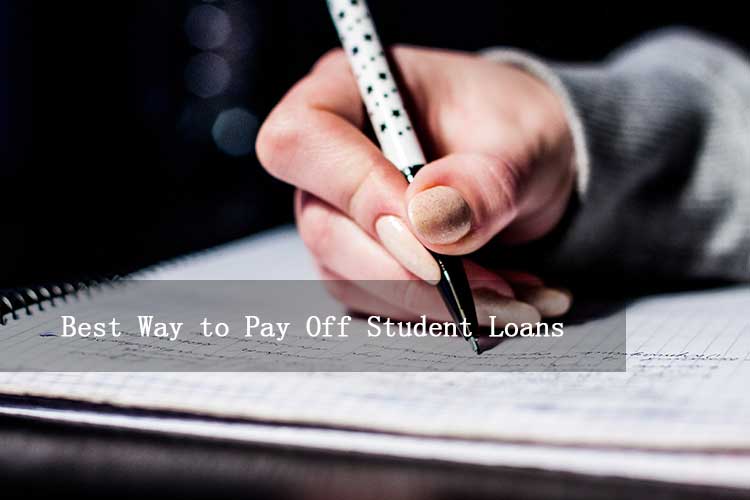
Student loans can feel like a significant financial strain, but with a solid plan in place, you can lessen that debt and relieve yourself from the stress of monthly payments. If you’re looking for the best way to pay off student loans, there are various strategies that can help you save both time and money. This article delves into the best approaches to speed up your debt repayment and handle your finances wisely.
Understand Your Loan Type
The initial step to effectively managing your student loans is to identify the types of loans you possess. Generally, student loans are categorized into two main types: federal loans and private loans. Federal loans usually provide more adaptable repayment options and lower interest rates, whereas private loans may have stricter conditions and higher interest rates.
- Federal Loans: These include Direct Subsidized, Direct Unsubsidized, and PLUS loans. Federal loans offer income-driven repayment plans and loan forgiveness options.
- Private Loans: Typically offered by banks or private lenders, these loans have varying interest rates and repayment terms based on your credit history.
Understanding your loans will help you determine the most appropriate repayment plan and whether refinancing might be an option. This is an important step in figuring out the best way to pay off student loans based on your individual needs.
Create a Budget and Payment Plan
A solid budget is crucial when tackling debt. By setting up a budget, you’ll know exactly where your money is going and how much you can allocate toward your student loans each month.
- Track Expenses: Begin by tracking your monthly expenses, including rent, groceries, utilities, entertainment, and student loans. Look for areas where you can cut back to free up more money for loan payments.
- Allocate Income: Make student loan payments a priority by designating a portion of your income toward them every month. Ensure you’re paying at least the minimum to avoid late fees and penalties.
Once you have a clear idea of your finances, you’ll have a better understanding of how much you can realistically contribute to paying off your student loans faster.
Make Extra Payments
One of the best ways to pay off student loans faster is by making extra payments whenever possible. When you pay more than the minimum required payment, the additional amount goes directly toward the principal, which reduces the amount of interest you pay over time.
- Set Up Biweekly Payments: Instead of making monthly payments, split your payment in half and pay every two weeks. This results in an extra full payment each year without much noticeable difference to your budget.
- Round Up Payments: If you have the flexibility, consider rounding up your payments. For example, if your payment is $365, round it up to $400. Those small extra amounts can chip away at the principal faster.
Extra payments can reduce both your loan balance and the interest accrued, helping you get out of debt faster.
Refinance Your Student Loans
Refinancing is an effective strategy to lower your interest rate and shorten your loan term. When you refinance, a private lender pays off your existing loans and issues you a new loan with new terms.
- Lower Interest Rates: If you have a good credit score, refinancing can help you secure a lower interest rate, reducing the total amount you’ll pay over the life of the loan.
- Shorter Loan Term: By choosing a shorter loan term (e.g., 5 or 7 years instead of 10 or 15), you can pay off your debt faster, although this may increase your monthly payment amount.
Refinancing is ideal for borrowers with private loans or high-interest federal loans. However, keep in mind that refinancing federal loans with a private lender means giving up federal benefits like income-driven repayment plans and loan forgiveness.
Explore Income-Driven Repayment Plans (IDR)
If your federal student loan payments are too high relative to your income, you may qualify for an income-driven repayment (IDR) plan. IDR plans base your monthly payments on a percentage of your discretionary income, potentially lowering your payments and extending the loan term.
- Types of IDR Plans: There are several types of IDR plans, including Pay As You Earn (PAYE), Revised Pay As You Earn (REPAYE), and Income-Based Repayment (IBR). Each plan has its own eligibility requirements and payment caps.
- Loan Forgiveness: After making payments for 20 to 25 years under an IDR plan, any remaining loan balance may be forgiven. Keep in mind that forgiven loan amounts may be considered taxable income.
While an IDR plan can offer relief, extending the loan term means paying more interest over time. This strategy is helpful if you’re struggling with high monthly payments.
Consider Loan Forgiveness Programs
Loan forgiveness programs can be an excellent way to reduce your student loan debt without paying it off entirely on your own.
- Public Service Loan Forgiveness (PSLF): If you work for a government or nonprofit organization, you may be eligible for PSLF. This program forgives the remaining balance on your Direct Loans after you make 120 qualifying monthly payments under a qualifying repayment plan.
- Teacher Loan Forgiveness: Teachers who work in low-income schools may be eligible for up to $17,500 in forgiveness on their Direct Subsidized and Unsubsidized Loans.
- Nursing and Healthcare Forgiveness: Several loan forgiveness programs exist for healthcare professionals, such as nurses and doctors, who work in underserved areas.
These programs require specific qualifications, so it’s essential to understand the eligibility requirements and application process.
Pay Off Loans with the Highest Interest First
The avalanche method is a popular debt repayment strategy where you focus on paying off loans with the highest interest rates first while making minimum payments on other loans. This method can save you money in the long run by reducing the total interest paid.
- List Your Loans: Make a list of all your student loans, sorted by interest rate. Prioritize paying off the loan with the highest rate first.
- Continue Making Minimum Payments: While focusing on the high-interest loan, continue making minimum payments on your other loans to avoid penalties.
The avalanche method is ideal for borrowers who want to minimize the amount of interest they pay.
Automate Your Payments
Setting up automatic payments for your student loans can help ensure you never miss a payment, which is crucial for avoiding late fees and maintaining a good credit score.
- Interest Rate Reduction: Many lenders offer a 0.25% interest rate reduction when you enroll in autopay. This can save you a significant amount of money over time.
- Consistency: Autopay ensures that your payments are made on time, which helps build your credit score and keeps your loans in good standing.
By automating your payments, you can also avoid the temptation to spend money elsewhere, keeping you focused on paying off your loans.
Take Advantage of Employer Repayment Assistance
Many companies now offer student loan repayment assistance as a benefit to their employees. This is an excellent opportunity to reduce your debt with the help of your employer.
- Ask Your Employer: If your employer offers this benefit, take full advantage of it. Some companies offer monthly contributions toward your student loans, which can help you pay off your debt faster.
- Maximize Employer Contributions: Even if your employer’s contributions are small, combining them with your own payments can significantly reduce your loan balance over time.
If you’re job hunting, look for companies that offer student loan repayment assistance as part of their benefits package.
Use Lump-Sum Payments When Possible
If you receive unexpected windfalls such as a tax refund, bonus, or inheritance, consider using that money to make a lump-sum payment toward your student loans. This can help you pay off a significant portion of your debt at once, reducing the principal balance and the amount of interest you’ll owe over time.
- Target High-Interest Loans: When making lump-sum payments, prioritize loans with the highest interest rates to maximize the impact.
- Prepay Without Penalty: Most student loans allow prepayment without penalty, so you can make extra payments without incurring fees.
By making occasional lump-sum payments, you can accelerate your repayment schedule and reduce the overall cost of your loans.
Conclusion
Finding the best way to pay off student loans depends on your financial situation and the types of loans you have. By gaining a clear understanding of your loans, setting up a budget, making additional payments, and considering alternatives such as refinancing or loan forgiveness, you can manage your student loan debt more effectively and achieve freedom from it sooner. With thoughtful planning and commitment, you can lessen your debt load and move closer to financial independence.



